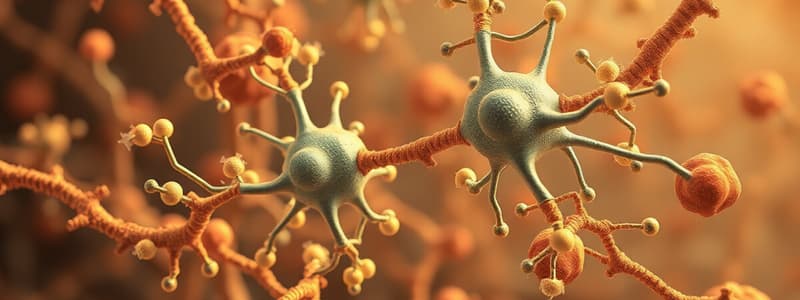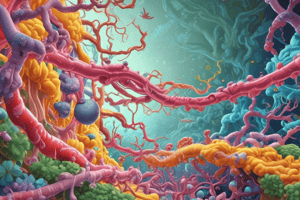Podcast
Questions and Answers
What is the primary role of inhibitory G-proteins (Gi)?
What is the primary role of inhibitory G-proteins (Gi)?
- To inhibit the production of cAMP (correct)
- To activate protein kinases
- To enhance cellular signaling
- To increase the production of cAMP
Which molecule is directly affected by the activation of Gi proteins?
Which molecule is directly affected by the activation of Gi proteins?
- Cyclic adenosine monophosphate (cAMP) (correct)
- Dopamine
- Cyclic guanosine monophosphate (cGMP)
- Acetylcholine
In what type of signaling mechanism do Gi proteins primarily function?
In what type of signaling mechanism do Gi proteins primarily function?
- Endocrine signaling
- Paracrine signaling
- Autocrine signaling
- G-protein signaling (correct)
What effect would the activation of Gi proteins have on cellular processes involving cAMP?
What effect would the activation of Gi proteins have on cellular processes involving cAMP?
Which of the following statements about cAMP is true?
Which of the following statements about cAMP is true?
Which type of receptor is characterized by its involvement in signaling through second messengers such as cAMP?
Which type of receptor is characterized by its involvement in signaling through second messengers such as cAMP?
What is the primary mechanism by which receptor density at the cell membrane can be controlled?
What is the primary mechanism by which receptor density at the cell membrane can be controlled?
Which receptor type primarily mediates effects by directly phosphorylating tyrosine residues?
Which receptor type primarily mediates effects by directly phosphorylating tyrosine residues?
G-protein coupled receptors utilize which type of molecular structure for signal transduction?
G-protein coupled receptors utilize which type of molecular structure for signal transduction?
In terms of effector pathways, nuclear receptors primarily influence which aspect of cell function?
In terms of effector pathways, nuclear receptors primarily influence which aspect of cell function?
What effect does the entry of chloride ions (Cl-) have on the charge inside the cell?
What effect does the entry of chloride ions (Cl-) have on the charge inside the cell?
Hyperpolarization in a cell is primarily a result of what ion entering the cell?
Hyperpolarization in a cell is primarily a result of what ion entering the cell?
What is the proposed effect of chloride ions entry on cell signaling?
What is the proposed effect of chloride ions entry on cell signaling?
Which term best describes the state of increased negativity inside a cell due to chloride ion entry?
Which term best describes the state of increased negativity inside a cell due to chloride ion entry?
In which scenario would you expect hyperpolarization to occur in a neuron?
In which scenario would you expect hyperpolarization to occur in a neuron?
What is the primary role of the binding site in the context of ligand interaction?
What is the primary role of the binding site in the context of ligand interaction?
What happens to GDP when a ligand binds to the receptor?
What happens to GDP when a ligand binds to the receptor?
What replaces GDP on the α subunit upon ligand binding?
What replaces GDP on the α subunit upon ligand binding?
Which of the following statements best describes the process when a ligand binds to a receptor?
Which of the following statements best describes the process when a ligand binds to a receptor?
What is the significance of GTP attaching to the α subunit?
What is the significance of GTP attaching to the α subunit?
Which type of drug is known to stabilize and reduce the activity of constitutive receptors?
Which type of drug is known to stabilize and reduce the activity of constitutive receptors?
What is a characteristic of drugs acting on type 4 receptors?
What is a characteristic of drugs acting on type 4 receptors?
Which drug mechanism is primarily responsible for reducing receptor activity?
Which drug mechanism is primarily responsible for reducing receptor activity?
What effect do drugs that act on type 4 receptors typically have on cellular signaling?
What effect do drugs that act on type 4 receptors typically have on cellular signaling?
In what way might a drug targeting a type 4 receptor influence physiological responses?
In what way might a drug targeting a type 4 receptor influence physiological responses?
What happens to α after it disassembles from the receptor?
What happens to α after it disassembles from the receptor?
Which proteins dissociate together from the receptor?
Which proteins dissociate together from the receptor?
What is the primary role of adenylate cyclase in this process?
What is the primary role of adenylate cyclase in this process?
Which of the following statements is true regarding the role of α in signaling?
Which of the following statements is true regarding the role of α in signaling?
What occurs immediately after α dissociates from the receptor?
What occurs immediately after α dissociates from the receptor?
Flashcards
Gi Protein
Gi Protein
Inhibitory G-protein, which reduces cAMP production.
cAMP
cAMP
Cyclic adenosine monophosphate, a second messenger important in cellular signaling.
G-protein signaling
G-protein signaling
A cellular mechanism where G-proteins transmit signals inside cells.
Chloride ions effect on cell charge
Chloride ions effect on cell charge
Signup and view all the flashcards
Hyperpolarization
Hyperpolarization
Signup and view all the flashcards
Inhibitory effect of chloride ions
Inhibitory effect of chloride ions
Signup and view all the flashcards
Drug Receptors
Drug Receptors
Signup and view all the flashcards
Signal Transduction
Signal Transduction
Signup and view all the flashcards
G-protein Coupled Receptors
G-protein Coupled Receptors
Signup and view all the flashcards
Tyrosine Kinase Receptors
Tyrosine Kinase Receptors
Signup and view all the flashcards
Nuclear Receptors
Nuclear Receptors
Signup and view all the flashcards
Receptor Density
Receptor Density
Signup and view all the flashcards
Two-state Model
Two-state Model
Signup and view all the flashcards
α subunit disassembles
α subunit disassembles
Signup and view all the flashcards
Adenylate Cyclase activation
Adenylate Cyclase activation
Signup and view all the flashcards
Binding Site
Binding Site
Signup and view all the flashcards
Ligand
Ligand
Signup and view all the flashcards
GDP
GDP
Signup and view all the flashcards
GTP
GTP
Signup and view all the flashcards
G-protein activation
G-protein activation
Signup and view all the flashcards
Drug that stabilizes/reduces receptor activity
Drug that stabilizes/reduces receptor activity
Signup and view all the flashcards
Property of a type 4 receptor drug
Property of a type 4 receptor drug
Signup and view all the flashcards
Study Notes
Pharmacodynamics II Lecture Notes
- Course: Pharmacodynamics II
- Date: 2024-2025
- Writer: Reem Alhussain
- Reviewer: Danial Abdulfattah
- Notes: 221-222-223
Objectives
- Describe the two-state receptor model
- Identify the four types of drug receptors and their signal transduction mechanisms
- Detail the molecular structure and effector pathways of G-protein coupled, tyrosine kinase, and nuclear receptors
- Explain the mechanisms controlling receptor density at the cell membrane
The Two-State Model
- Receptors exist in two states: resting (R) and activated (R*)
- In the absence of a ligand, equilibrium favors the resting state (R)
- Ligands (e.g., drugs, hormones, enzymes) shift the equilibrium toward the activated state (R*)
Agonists
- Agonists bind to the resting state of the receptor
- They shift the equilibrium towards the activated state (R*)
- This binding initiates a response
Constitutive Receptor Activation
- Some receptors exhibit activation even without a ligand (constitutive activation)
- This can be due to spontaneous receptor mutations or disease states
- Inverse agonists stabilize constitutively active receptors, reducing their activity by shifting the equilibrium to the left
Types of Receptors
- Type 1 (Ligand-gated ion channels): Fast neurotransmission; ligand binding opens ion channels, leading to rapid cellular responses.
- Type 2 (G-protein coupled receptors): Metabotropic receptors; ligand binding activates G-proteins, triggering a cascade of intracellular events.
- Type 3 (Tyrosine kinase receptors): Ligand binding activates tyrosine kinase enzymatic activity, resulting in modulation of cellular processes.
- Type 4 (Nuclear receptors): Located inside the cell; ligand binding activates gene transcription, leading to delayed effects
G-protein Signaling Mechanism
- Step 1: Ligand binding to receptor
- Step 2: Conformational change in receptor activates G-protein
- Step 3: G-protein alpha subunit dissociates from beta/gamma subunits
- Step 4: G-alpha subunit activates an effector molecule (e.g., adenylate cyclase)
- Step 5: Effector molecule produces a second messenger (e.g., cAMP)
- Step 6: Second messenger activates downstream signaling pathways
Tyrosine Kinase Receptors
- Extracellular domain, transmembrane domain, and intracellular domains
- Ligand binding causes dimerization and activation of intracellular tyrosine kinase activity
- Activated receptors phosphorylate intracellular proteins, initiating downstream signaling pathways
Nuclear Receptors
- Located inside the cell (cytoplasm/nucleus)
- Ligands must be highly lipid-soluble to cross the cell membrane.
- Ligand binding regulates gene transcription, affecting protein synthesis
- Action is relatively slow, taking hours or days to manifest.
Desensitization and Tachyphylaxis
- Gradual decrease in drug effect with continuous or repeated administration
- Can be due to receptor changes, mediator exhaustion, increased drug metabolic degradation, or active drug extrusion from cells
Tolerance
- Gradual reduction in drug responsiveness over days or weeks
- Involves various mechanisms, including receptor changes, mediator exhaustion, and drug metabolic degradation
Control of Receptor Expression
- Up-regulation: Increase in receptor expression in response to continuous inhibition
- Down-regulation: Decrease in receptor expression in response to continuous stimulation
Quiz Questions and Answers (included in the image)
Studying That Suits You
Use AI to generate personalized quizzes and flashcards to suit your learning preferences.



